NRAO Newsletter
Volume Vol#, Issue Iss#
Day# Month# Year#
NRAO Newsletter
Volume Vol#, Issue Iss# • Day# Month# Year#
 The Karl G. Jansky Very Large Array in New Mexico. Photo by Brian R. Kent (NRAO/AUI/NSF).
The Karl G. Jansky Very Large Array in New Mexico. Photo by Brian R. Kent (NRAO/AUI/NSF).
Upcoming Events

Jansky Lecture Socorro
November 17, 2023 | Socorro, NM

ALMA at 10 years: Past, Present, and Future
December 4 - 8, 2023 | Puerto Varas, Chile

NRAO at the New Orleans AAS
January 7 - 11, 2024 | New Orleans, LA
NRAO Science Ready Data Products - Take Our Survey
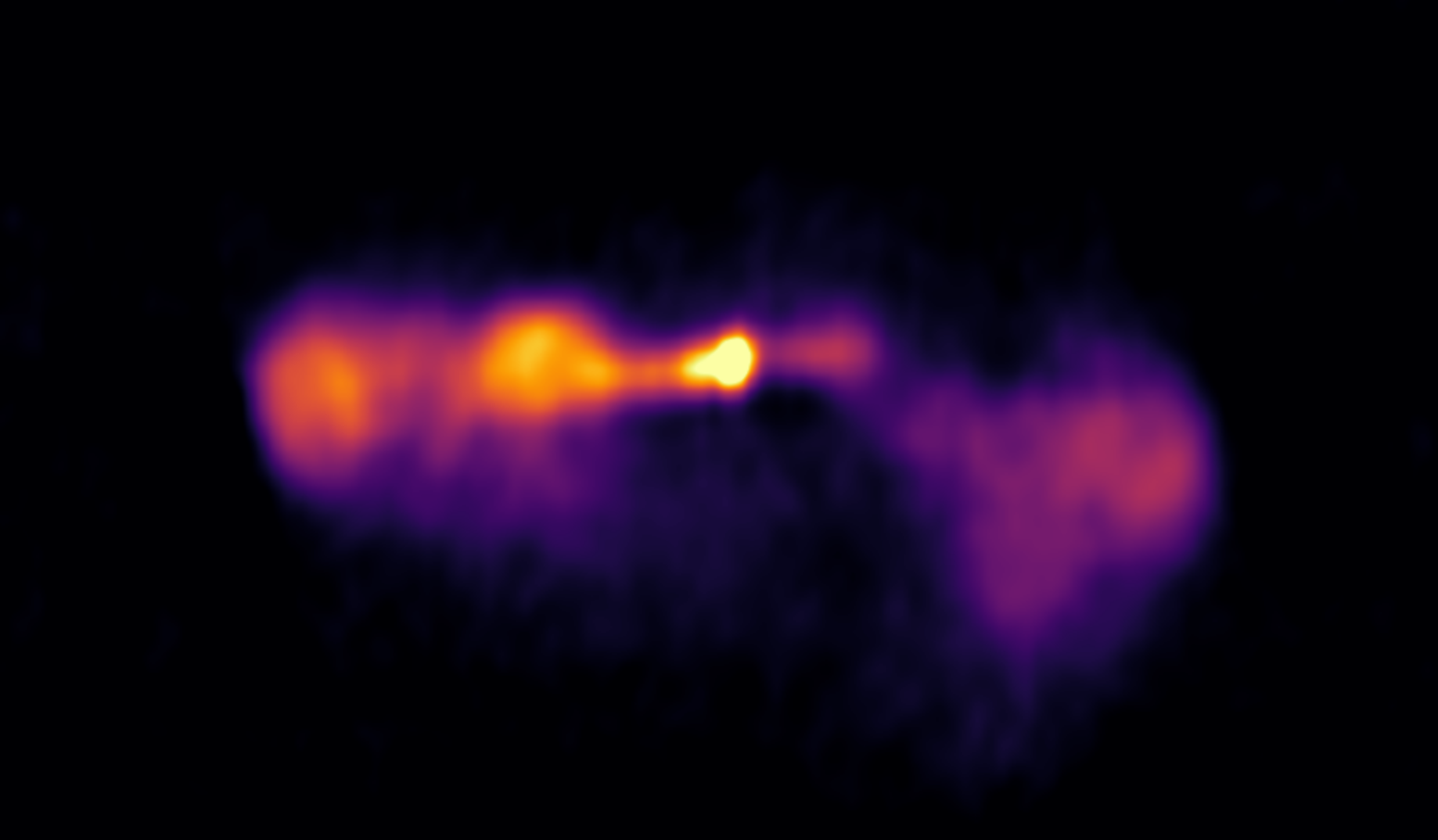
VLA Sky Survey
NRAO's Science Ready Data Products (SRDP) program aims to provide users with a variety of both user-initiated and standard pipeline processed datasets that can either be used directly for science purposes, or can provide a starting point for users to create their own. We are interested in obtaining user feedback both on the products derived from this program and the most useful directions for future development. To help us with this effort, we would be grateful if you could fill out our short survey.
NRAO in the Spotlight: ADASS 2023 Photos
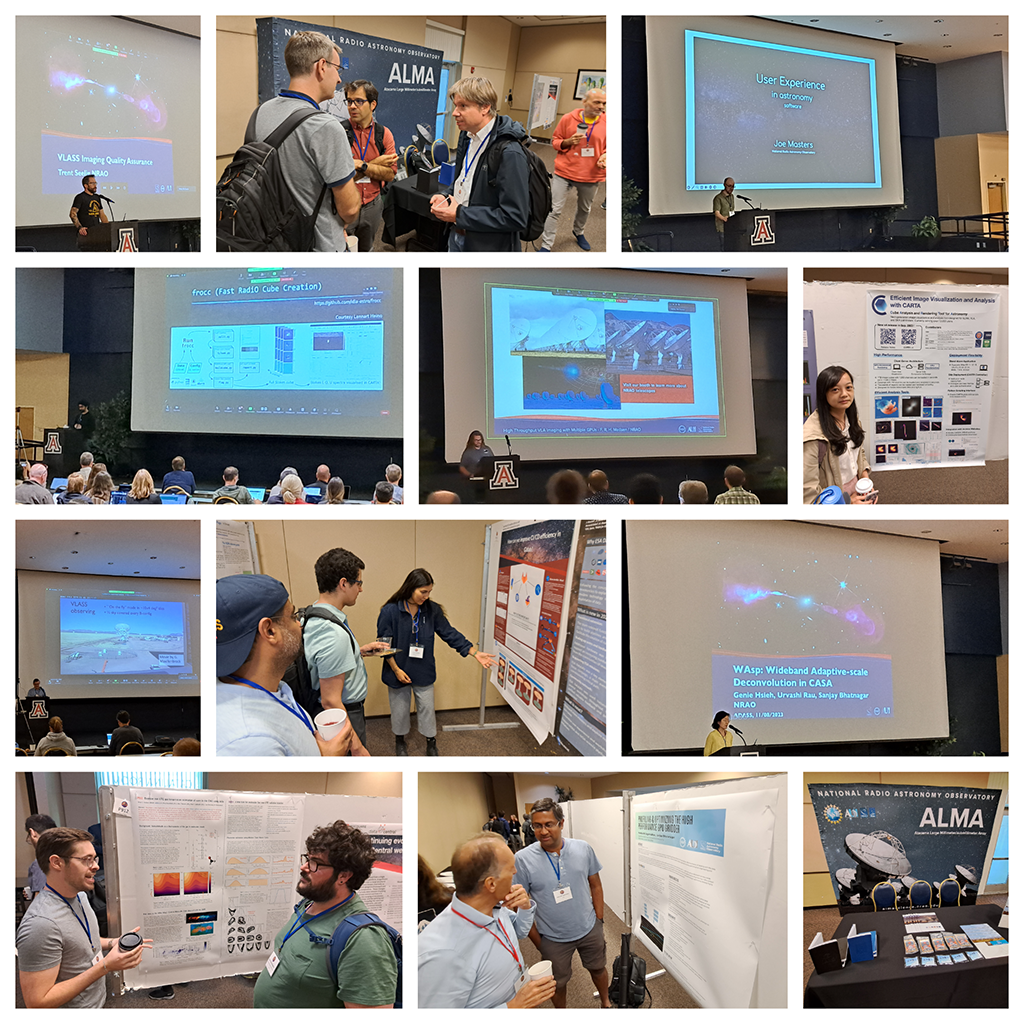
Brian R. Kent (NRAO/AUI/NSF)
[click to enlarge]
ADASS 2023 Astronomy Computing Conference Recap
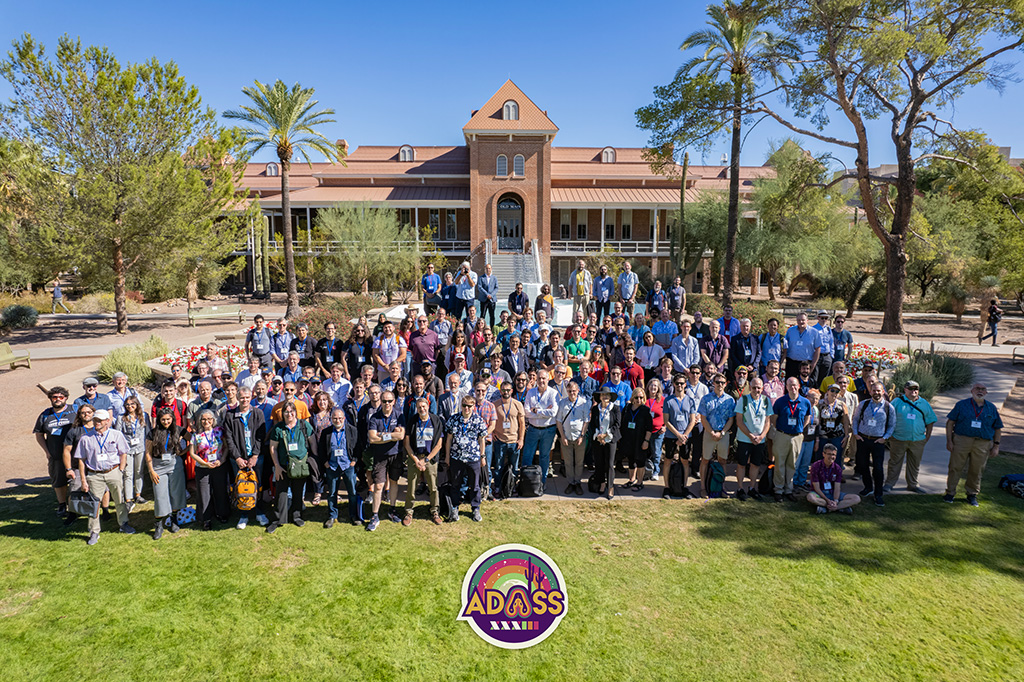
Photo by Peter Marenfeld.
NRAO was a sponsor and participant in the Astronomy Data Analysis Software and Systems XXXIII (ADASS) conference in Tucson, Arizona. Held November 4-10, 2023 on the University of Arizona campus, the meeting covered a wide range of computing topics in astronomy, with over 380 participants both in person and remote around the world. Recordings of the talks are currently being posted. NRAO presentations are included in the table below. Thanks to Rob Seaman and Alice Jacques from NOIRLab, and the organizing committees for a well organized and productive conference.
| Presenter | Title |
|---|---|
| Joe Masters | User Experience and its role in astronomy |
| Trent Seelig | Automation of VLASS Quick Look Image Quality Assurance |
| Felipe Madsen | High throughput VLA Imaging with multiple GPUs |
| Genie Hsieh | An Adaptive-Scale Multi-Frequency CLEAN Deconvolution in CASA for Radio Interferometric Images |
| Mark Lacy | The VLA Sky Survey |
| Srikrishna Sekhar | A Good IDIA : Scientific Computing at Scale |
| Brian Svoboda | Bayesian non-LTE gas temperature estimation of cores in the CMZ using Julia |
| Yu-Hsuan Hwang | Efficient Image Visualization and Analysis with CARTA |
| Preshanth Jagannathan | Profiling and Optimizing the High Performance Gridder |
NRAO Ambassadors Program

Photo by Jeff Hellerman (NRAO/AUI/NSF).
The National Radio Astronomy Observatory (NRAO) is soliciting interest for an NRAO Ambassadors Program. This program will provide training and compensation to postdoctoral researchers, senior graduate students, and early career researchers interested in expanding their knowledge of connected radio interferometry and very long baseline interferometry (VLBI) as well as the capabilities offered by the Karl G. Jansky Very Large Array (VLA) and the Very Long Baseline Array (VLBA). NRAO Ambassadors support the community by organizing and hosting workshops that cover one, or any combination, of the following topics:
- Proposal preparation prior to NRAO proposal deadlines
- Observation preparation prior to the start of NRAO observing semesters, and/or
- Data processing and analysis.
While the events will focus on VLA/VLBA proposal preparation, observation preparation, and/or data processing and analysis, participants will also have the opportunity to work with data from the VLA Sky Survey (VLASS) and to learn about the status and upcoming plans for the Next Generation Very Large Array (ngVLA).
NRAO will provide travel support for the training as well as all talk materials, supplies, and infrastructure support for the workshops hosted by the NRAO Ambassadors. Training and compensation for hosting a VLA/VLBA event will also be offered commensurate to the ALMA Ambassadors. While some connected radio/centimeter interferometry and VLBI experience is preferred, it is not formally required.
NRAO will host the selected Ambassadors at its headquarters in Charlottesville, VA, or at the Domenici Science and Operations Center in Socorro, NM, to receive in-depth training. Participants will receive training on topics listed above and may include, but not limited to, VLA/VLBA proposal preparation (radio interferometry basics, VLA/VLBA science capabilities, use of the Proposal Submission Tool), VLA/VLBA observing preparation (use of the Observation Preparation Tool and SCHED), and VLA/VLBA data processing and analysis with CASA as well as data visualization using CARTA. Ambassadors will have access to recent NRAO and ngVLA highlights and guidance for speaking on these topics. The training also includes a poster session where Ambassadors will showcase their own science to their fellow ambassadors and the local astronomical community, including NRAO staff.
Proposal preparation, observation preparation, and/or data analysis and processing workshops may be held at the Ambassador's home institute, an alternate location, or virtually. In addition, NRAO Ambassadors will make themselves available to help their local community between the call for proposals and the deadline, and support other NRAO activities.
We particularly encourage applications from those interested in the data processing and analysis workshops, or in targeting specific scientific communities (e.g., time domain and/or multimessenger astrophysics).
To apply for this opportunity, please fill out the following NRAO Ambassador Google Form by December 15, 2023. For more information and questions about this opportunity, please contact Anthony Remijan.
CIRADA DRAGNs Catalog for VLASS
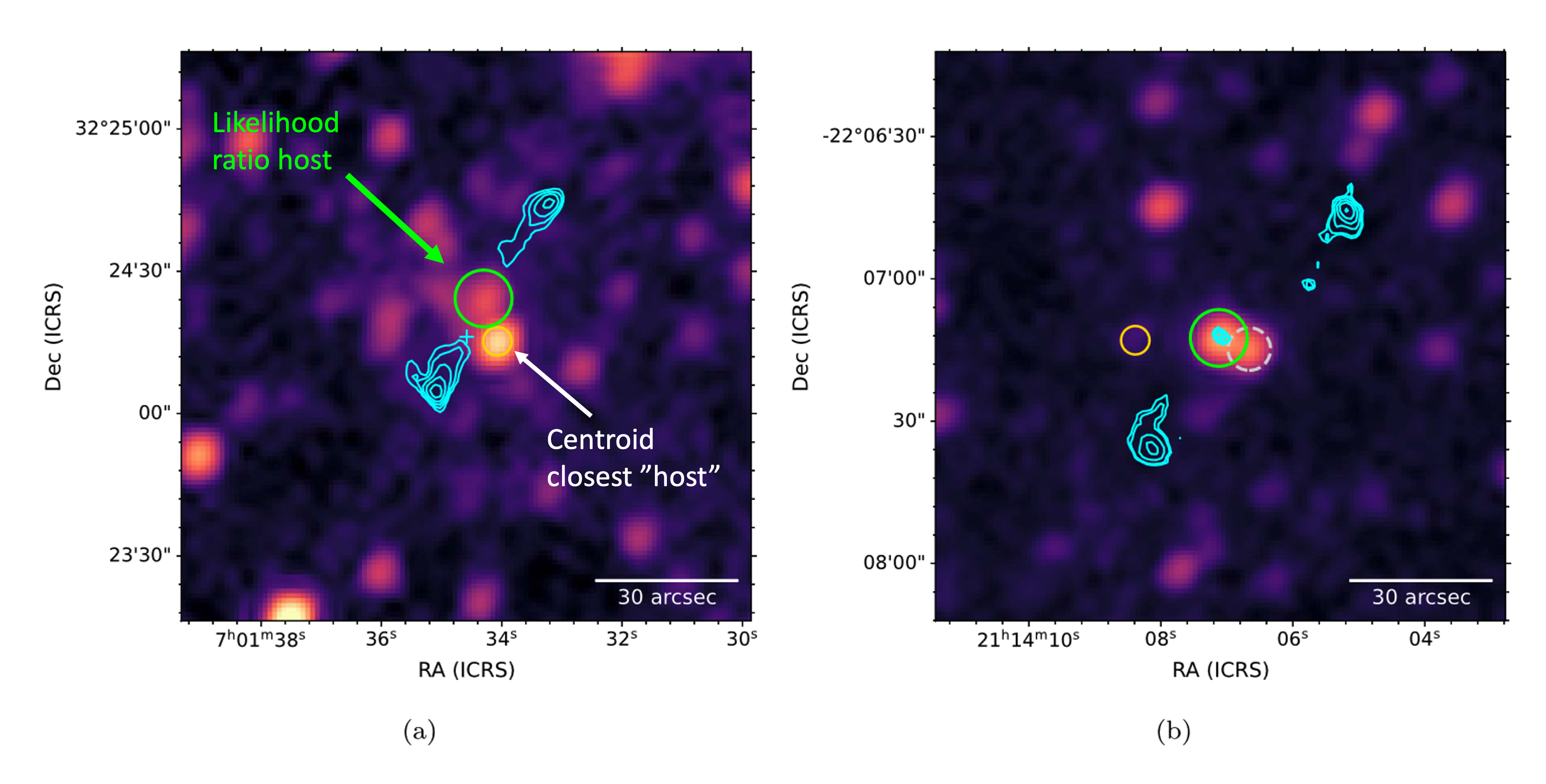
Above: Example unWISE W1-band images for DRAGNs where multiple host candidates are considered, showing the radio emission overlaid with cyan contours. Yellow circles are used to show AllWISE sources that are initially identified as being near the central position of the DRAGN (cyan cross) but are rejected as the host. The larger green circles show the adopted host. In panel (a) no radio core has been identified, and the host ID is selected as the most probable match from the likelihood ratio (R = 0.75). Panel (b) shows an example DRAGN where a core has been identified, and this information has been used to update the host ID. Here, the gray dashed circle shows the AllWISE source that the likelihood ratio has identified as the most probable match (R = 0.59) but that was replaced by the host candidate coincident with the radio core (green circle). From Gordon et al., 2023, ApJS, 267, 37.
Release of Double Radio Galaxy (DRAGNs) Catalog and Machine Learning-Based Morphological Annotations for VLASS
The Canadian Initiative for Radio Astronomy Data Analysis (CIRADA) is excited to announce the release of a double radio galaxy catalog and new machine learning classifications for the VLASS Quick Look epoch 2 data. The Double Radio Galaxy (DRAGNs) Catalog contains over 17,000 double-lobed radio galaxies and supplementary information such as host IDs and, where possible, redshift measurements. We also include a value-added list of more than 500,000 single-component radio sources. DRAGN catalogs are now available for each of the existing component catalogs, namely Quick Look 1, 2 and Single Epoch 2. Researchers can access the catalog and the accompanying software on our website. Detailed descriptions are provided in Gordon et al., 2023, ApJS, 267, 37.
CIRADA also now introduces morphological annotations of radio sources created using a Self-Organizing Map (SOM) for the epoch 2 data. This unsupervised machine learning technique classifies VLASS sources based on their distinct morphologies into 100 different classes or 'neurons'. Such classifications not only provide quality flags to identify bad data but are also beneficial for researchers interested in creating samples based on radio morphologies. Details of potential issues and guidance on such selection are provided in the Catalog User Guide.
With this release, we have also corrected any astrometry errors that corrupted the previous versions of the Quick Look epoch 1 catalog.
ALMA Program News
 Photo by Pablo Carrillo.
Photo by Pablo Carrillo.
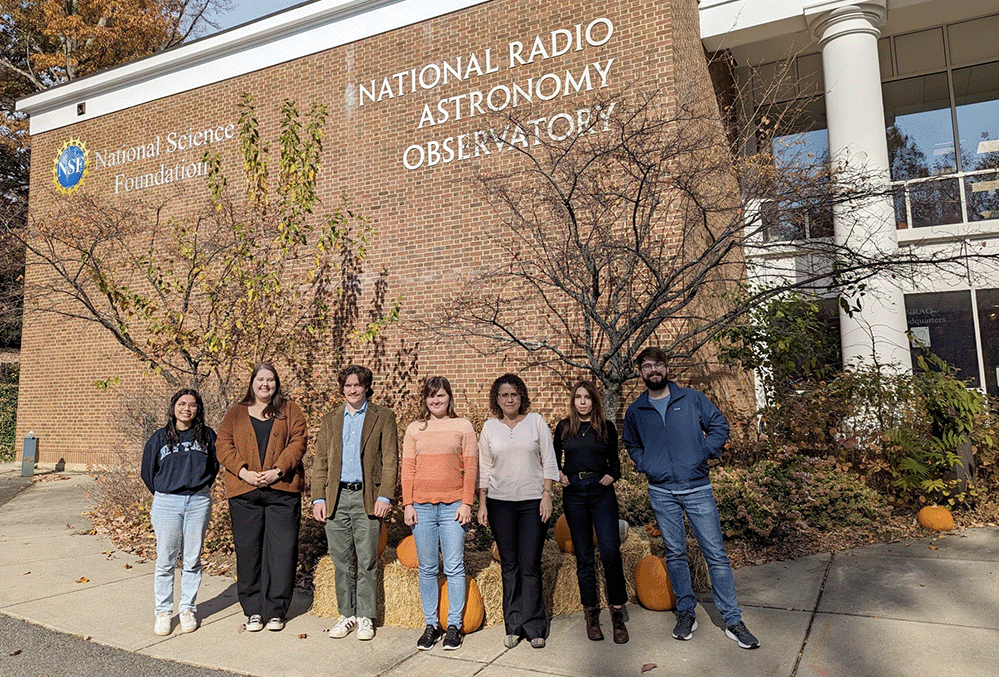
Users participate in the ALMA Data Reduction Party activities in Charlottesville, VA, which took place November 06-08, 2023.
[click to enlarge]
ALMA Observing Status
After inspection of the antenna transporters, five antenna moves have been performed from configuration C-8 towards configuration C-7, filling 46 out of the 50 pads in the C-7 configuration. During the next few weeks, more antenna moves will be carried out after the transporters undergo the necessary repairs with the objective of, as much as possible, catching up with the original configuration calendar.
ALMA Band 1 Science Verification Data
The Science Verification data for W51 observed on 25 March 2023 and 4 April 2023 are now available on the Science Portal. The data were obtained in the observations of spectral lines (CS, SiO, CH3OH, and SO2) and continuum in Band 1, with the total on-source time of about 70 minutes.
Release of Solar Full Polarization ALMA Test Data
ALMA has released data acquired as part of the Extension and Optimization of Capabilities effort (EOC). The data were used to test, implement, and determine the accuracy of the solar full-polarization observing mode of ALMA. The data are available here (please refer to the readme file at each of these locations for information on the content of the files).
AAS Special Session: ALMA as a high-z powerhouse - the impact of the Wideband Sensitivity Upgrade
The NAASC will host a special session at the upcoming Winter AAS Meeting in New Orleans, held on Monday, January 8, 2024, 10am to 11:30am (Central Time). This special session will present high-profile results obtained through ALMA programs in different areas of high-z studies - including large programs, current and expected synergies with high-sensitivity facilities, and the expected yield from ALMA observations after different phases of the Wideband Sensitivity Upgrade (WSU) are achieved. The session will include four invited talks by J. Yang (U. Arizona), A. Long (UT Austin), J. Spilker (Texas A&M) and D. Burgarella (LAM Marseille), and a general presentation about the WSU.
More information can be found on NAASC science website.
Support for Conferences and Workshops
The North American ALMA Science Center (NAASC) invites members of the North American (US and Canada) scientific community to apply for funding in support of inclusive conferences and workshops in fiscal year 2024. We prioritize events which encourage the participation of students, postdocs, and early career researchers. PI-led events based in the US or other national or international conferences may be considered. We will accept applications for funding below $10K at any time while funds for fiscal year 2024 last. More information can be found on the conferences and workshops section of the science website.
Dust Devils Workshop: Debris Disks in the Sonora Desert
Meeting Website (March 25-29, 2024; Tucson AZ; Registration Deadline November 30, 2023)
After Victoria 2018, Budapest 2019, EAS 2021, and Jena 2022, Steward Observatory and University of Arizona will host the fifth edition of the Current and Future Trends in Debris Disk Science meetings series in the Grand Canyon state! This meeting aims to provide an informal setting in which students and early career researchers can network, present their work, and learn about debris disks. Note that there will be a crash course of two days preceding the meeting for those who are brand new to the field.
Registration is now available and will remain open until November 30, 2023 for in-person attendance (or until the 120 people cap is reached). Thanks to funding from NASA and the NAASC, the meeting has no registration fee, and award travel support is available for people who otherwise don't have funds available to attend.
ngVLA Project News
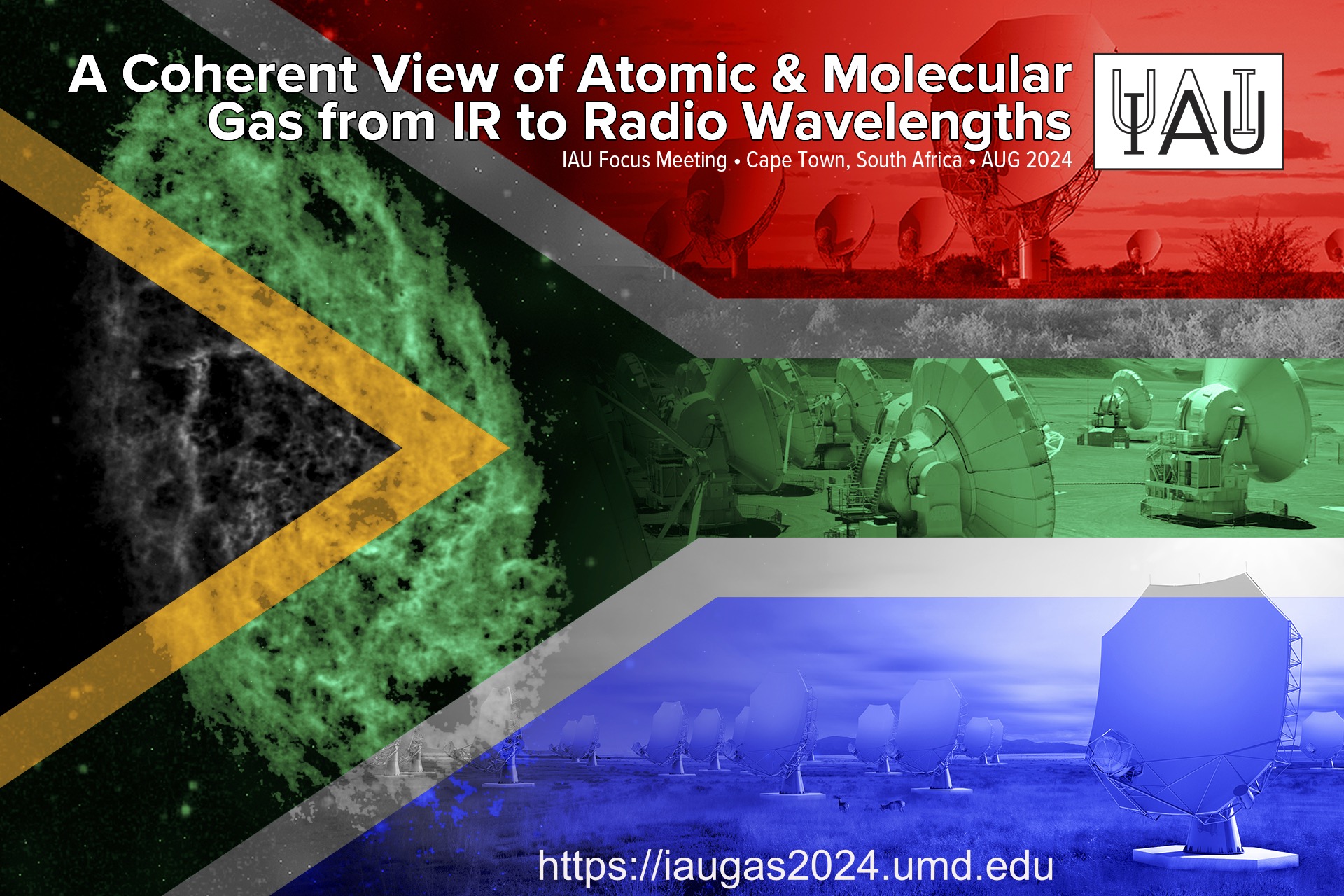
Jeff Hellerman (NRAO/AUI/NSF)
A Coherent View of Atomic and Molecular Gas from Infrared to Radio Wavelengths
This meeting will be held in August 2024 in Cape Town, South Africa, at the XXXII International Astronomical Union General Assembly. The Focus Meeting will explore how the work taking place at existing facilities is shaping our understanding of the interstellar medium structure and feedback in our own Milky Way and external galaxies, and how this work is re-framing the science that will be addressed by the remarkable capabilities of future radio observatories. Key Focus Meeting organizers are Alberto Bollato (U Maryland), Nami Sakai (RIKEN) and Eva Schinnerer (MPIA). Invited speakers will be announced on December 1, 2023. Registration for the Focus Meeting is open.
ngVLA Science - Unveiling Supermassive Black Hole Binaries
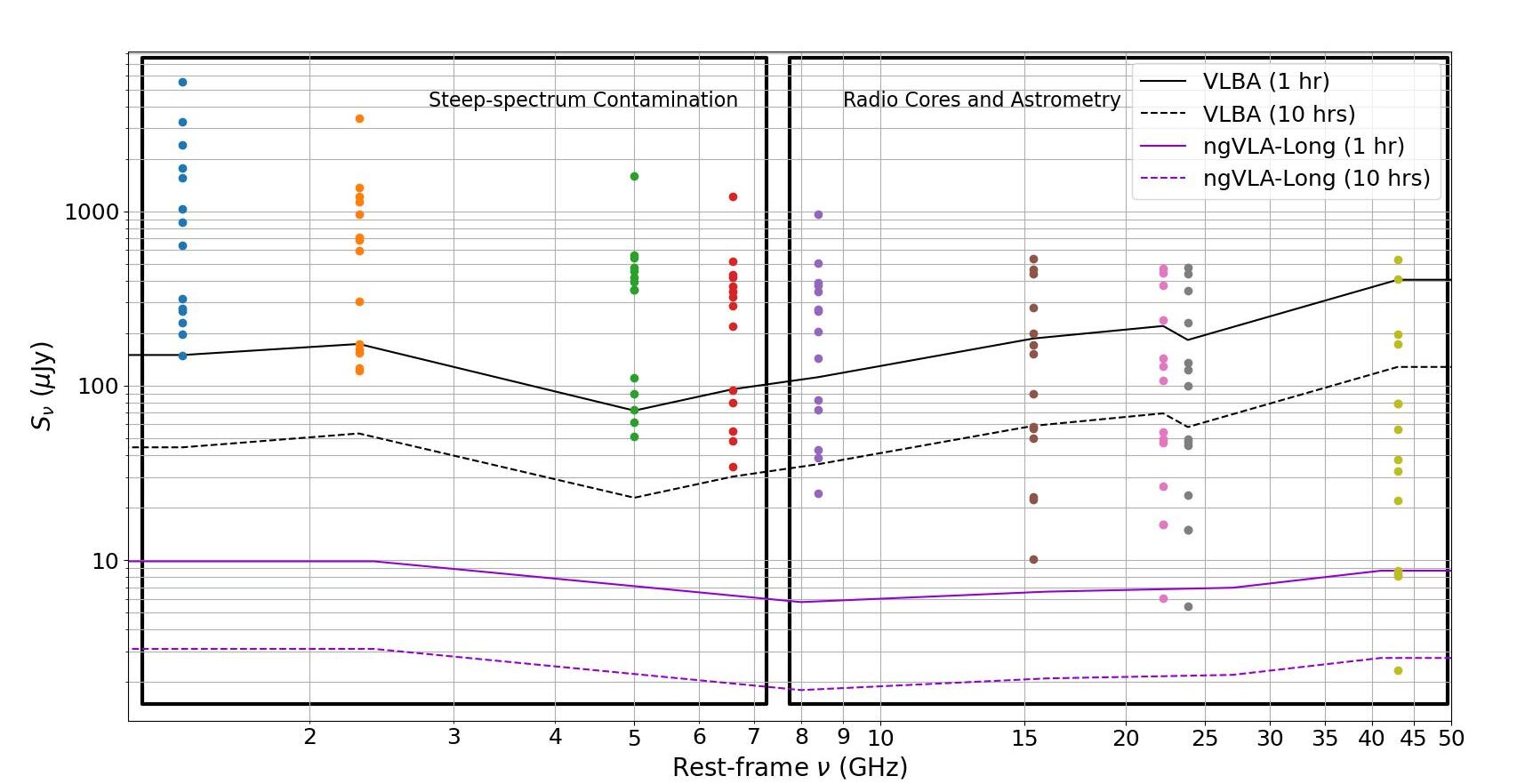
[click to enlarge]
Expected VLBI-scale flux densities for the 14 radio AGN (symbols) and 5 detection thresholds (lines). Adapted from Walsh & Burke-Spolaor 2023.
Pulsar timing arrays are revealing mounting statistical evidence for the nanohertz gravitational wave background (Agazie et al. 2023a; Antoniadis et al. 2023; Reardon et al. 2023; Xu et al. 2023). This background is most likely due to a cosmological population of merging supermassive black hole binaries (SMBHBs) with sub-pc orbital separations (Agazie et al. 2023b). Much theoretical work has been devoted to characterizing the evolution of SMBHBs, but electromagnetic observations have noticeably lagged due to the difficulties of detecting bonafide SMBHBs. To date, only one SMBH pair has strong evidence for binary formation (Rodriguez et al. 2006). Large samples of confirmed SMBHBs are needed to constrain their electromagnetic signatures, evolutionary timescales, and effects on their host galaxies through feedback mechanisms.
Post-merger galaxies - merger remnants with a single stellar bulge but robust tidal features - are natural laboratories to search for SMBHBs, as they are at an advanced stage of galaxy merger evolution. In Walsh and Burke-Spolaor (2023), we present high resolution (approximately 360 pc) VLA observations at 10 GHz of 28 post-merger galaxies. We add multiwavelength data to build a holistic description of these post-mergers and constrain the astrophysical engine driving their nuclear radio emission. We find that 14 radio sources are likely associated with an AGN. Each radio AGN may mark an unresolved SMBHB at these spatial scales in a post-merger host.
The superior angular resolution of VLBI could provide strong evidence for a SMBHB by revealing multiple flat-spectrum radio cores with a pc-scale separation. We extrapolate to the VLBI-scale flux density expected for each radio AGN. We then simulate 1-hr and 10-hr integrations with the VLBA and ngVLA-Long over 1-50 GHz, to assess the ability of these instruments to perform SMBHB searches in these post-mergers. The figure shows that ngVLA-Long will excel in these searches for frequencies around 10 GHz, where the presumptive radio cores are the dominant emission features and high-precision, time-domain astrometric campaigns could provide corroborating evidence for binary evolution (e.g., Wrobel and Lazio 2022). ngVLA-Long will be a powerhouse instrument for SMBHB detection and characterization, and will open the window into multi-messenger astronomy at the highest BH mass scales.
Since 2015 the acronym ngVLA has appeared in 1050+ publications indexed in the SAO/NASA Astrophysics Data System. This article continues a regular feature intended to showcase some of those publications. We are especially interested in showcasing work done by early-career researchers. The collection of showcase articles can be viewed online. Anyone wishing to volunteer to author a feature should contact Joan Wrobel.
CASA 6.5.4-9 with Pipeline 2023.1.0.124 Released for VLA Data Processing
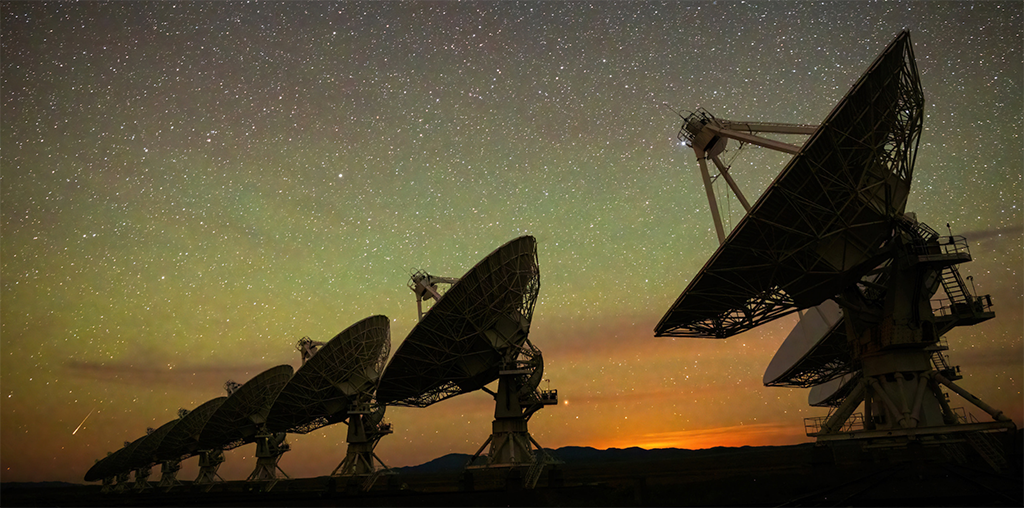
Photo by Bettymaya Foott (NRAO/AUI/NSF).
The CASA and NRAO pipeline teams have released a new version of the VLA calibration and imaging pipeline (2023.1.0.124), running on CASA 6.5.4-9. This version is now installed on NRAO systems and can be downloaded by users. This version of CASA and the pipeline are identical to what is used for ALMA data processing, thus users can process data for both telescopes with the same package. Data processing at NRAO with the new pipeline began at the start of the VLA D-configuration, during late October 2023.
The primary new features of the pipeline that are specific to the VLA are:
- An automated target self-calibration task is now included in the VLA imaging pipeline.
- More fine-grained control of receiver gain compression correction is available via the hifv_syspower task. This especially helps multi-band data where the compression correction is not intended to be applied to all bands. Moreover, when multiple bands need to have the correction applied, the antennas that need to be excluded can be controlled on a per-band basis as well. Plots are also produced for K, Ka, and Q-bands for informational purposes. We emphasize that the compression correction should not be applied for 3-bit data.
- There are now datatype specifications that should be provided upon the import of data into the VLA imaging pipeline for proper execution, see the VLA imaging pipeline webpage for more detail.
- L and S-band imaging now use the wproject gridder for imaging.
- A bug that ignored antenna position corrections when Bx=By=0 and Bz!=0 was fixed.
- A bug was fixed in the hifv_pbcor task that caused it to fail when imaging using multiple measurement sets.
- The pipeline task parameter 'pipelinemode' has been removed from all pipeline tasks. Scripts that contain pipelinemode='automatic' will continue to function at present, but should be updated to remove this deprecated parameter.
- Known issue: The TEC data format changed and datasets observed after August 7, 2023 cannot have their TEC data fetched when using the CASA helper script used by the pipeline. A future version of CASA and the pipeline will restore this functionality.
A more detailed description of the VLA Calibration pipeline is available, as is a description of the VLA Imaging pipeline. More information about automated self-calibration is available here. See the ALMA pipeline documentation for general, non-VLA-specific infrastructure changes.
International Symposium on Space Terahertz Technology 2024 - Call for Abstracts
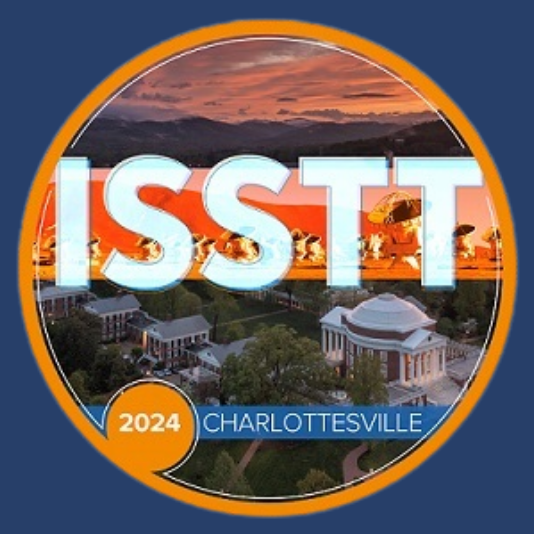
This is the Call for Abstracts for the 33rd IEEE International Symposium on Space Terahertz Technology (ISSTT 2024). The Symposium will be held in Charlottesville, Virginia USA from April 7-11, 2024.
In 2024, the Symposium will again focus on millimeter- and submillimeter-wave and Terahertz technologies, and their applications in astronomy, planetary science, Earth science, and general remote sensing. There will be a student paper contest and our special theme in 2024 will be metamaterials and their use.
Submissions for the ISSTT 2024 meeting will be in the form of one-page abstracts. Student competition entries are encouraged to be two pages. All abstracts should be uploaded by January 14, 2024 as a pdf file on the Symposium website. For more information, visit the conference website.
SACNAS 2023 Conference Recap
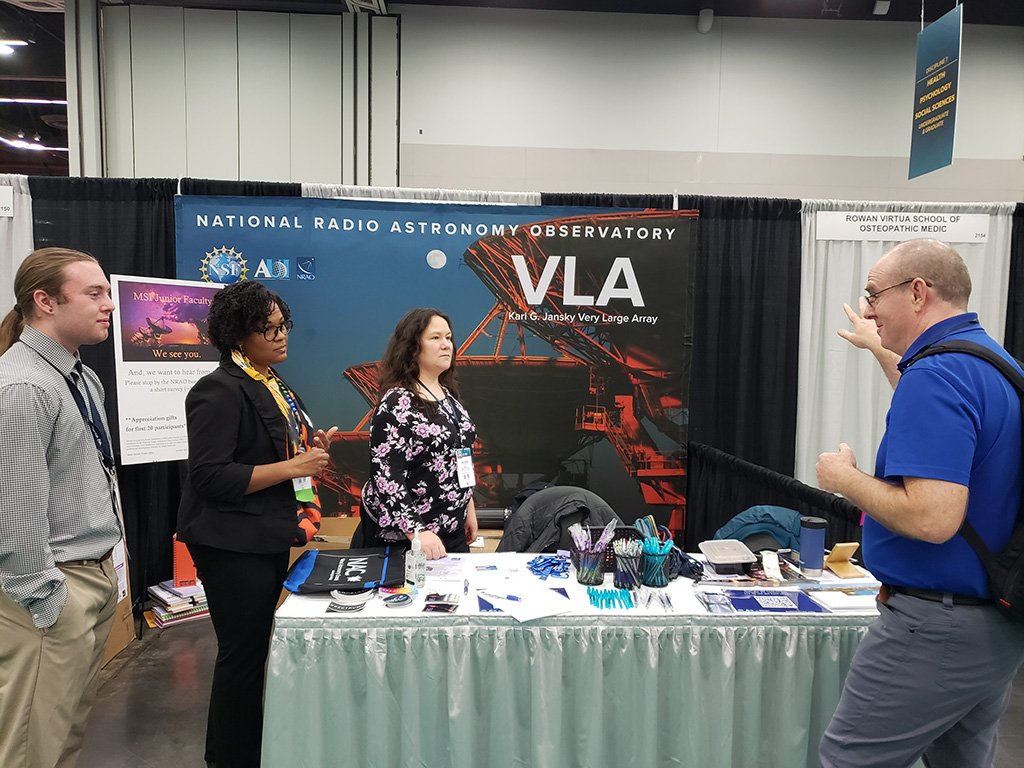
Anja Fourie (NRAO/AUI/NSF)
NRAO staff participate in the 2023 SACNAS Conference.
[click to enlarge]
NRAO participated in the Society for the Advancement of Chicanos/Hispanics and Native Americans in Science Conference (SACNAS) in Portland, Oregon, October 26-28, 2023. NRAO programs were shared with conference attendees, showcasing the facilities and student program opportunities available to the community.
Call for Proposals of the 40-m Thai National Radio Telescope
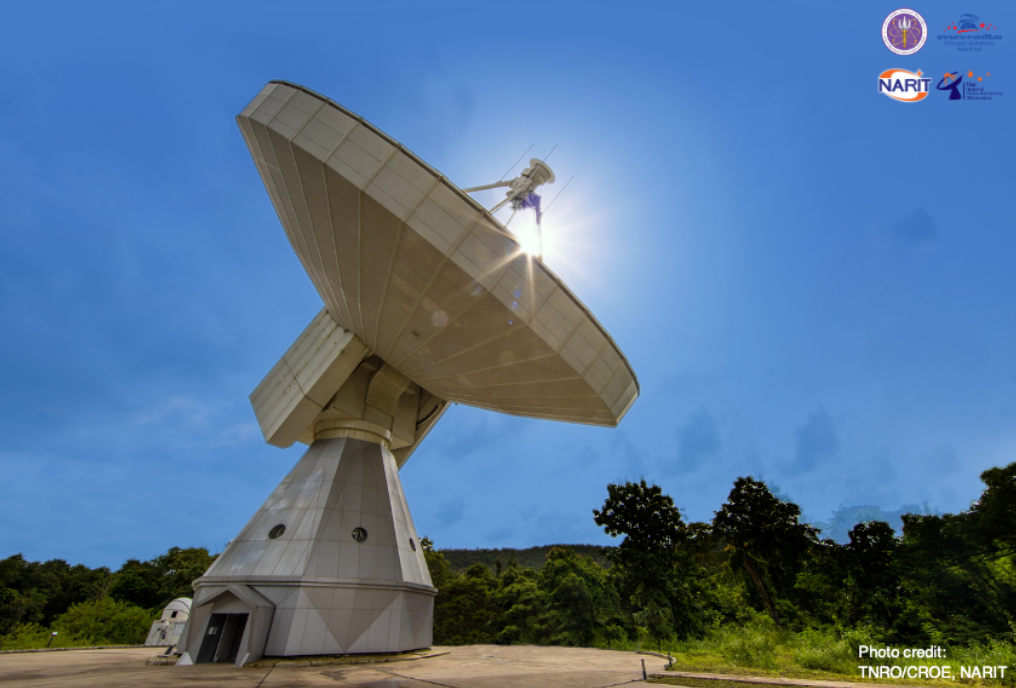
TNRO/CROE, NARIT
The Thai National Radio Observatory (TNRO), a National Astronomical Research Institute of Thailand (NARIT, a Public Organization), is honored to announce the 1st Call for Proposals (CfP) of the 40-m Thai National Radio Telescope (TNRT) as Cycle 0 in a Resident Shared Risk Observing (RSRO) program. TNRO is located at Huai Hong Khrai Royal Development Study Centre, Doi Saket District, Chiang Mai, in the northern part of Thailand.
The 40-m TNRT is developed in collaboration with Yebes Observatory, the National Geographical Institute (IGN), and is capable of receiving a wide-range of frequency coverage from 0.3 to 115 GHz. Key science cases achievable with the 40-m TNRT is published as a white paper (Jaroenjittichai, et al. 2022; arXiv:2210.04926). In cycle 0, proposers are invited to request time on the 40-m TNRT for the L-band spectrometer mode, which can be used for observations of lines like OH masers, and continuum emission. The L-band receiver installed at the prime focus is developed in collaboration with Max Planck Institute for Radio Astronomy. The details with the status report and definition of RSRO style are provided at the CfP website.
Recent Science Media Releases
|
ALMA Observation of Young Star Reveals Details of Dust Grains |
|
|
ALMA - Highest Resolution Observations Ever |
|
|
New US and Japan Partnership Will Make the World's Most Powerful Telescope Even More Sensitive |
|
|
A Supermassive Black Hole's Strong Magnetic Fields are Revealed in a New Light |
|
|
Contact the NRAO press office to share your new and exciting science results. |
From the Archives
Ellen Bouton

[click to enlarge]
About this month's photo: In 1965, NRAO staff members take an autumn hike near Green Bank. Left to right: George Swenson, Heinz Wendker, May Kaftan-Kassim, Jaap Baars, Hein Hvatum, Cam Wade. Photo taken by Bertil Hoglund.
From the Archives is an ongoing series illustrating NRAO and U.S. radio astronomy history via images selected from our collections of individuals' and institutional papers. If readers have images they believe would be of interest to the Archives, please contact Ellen Bouton.

